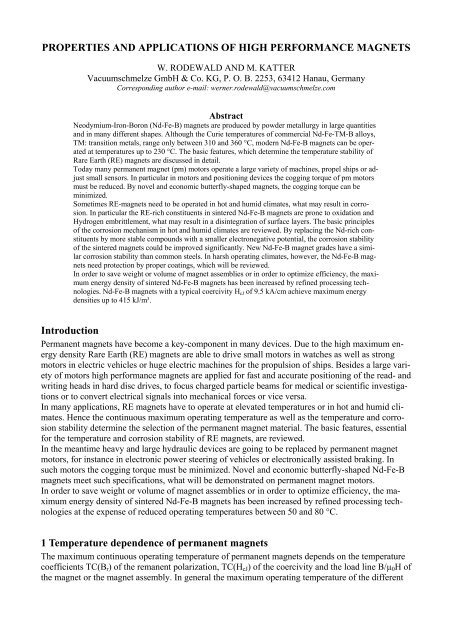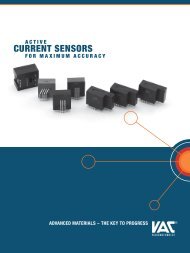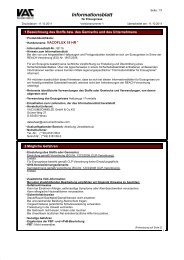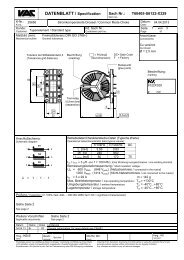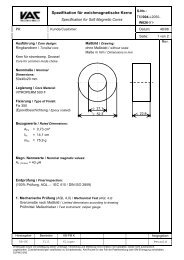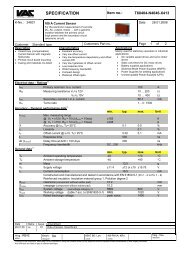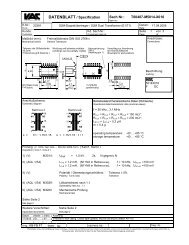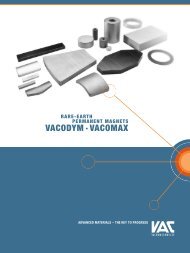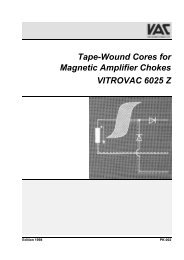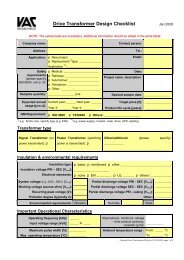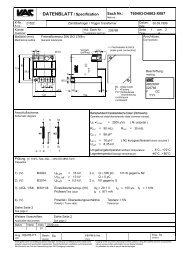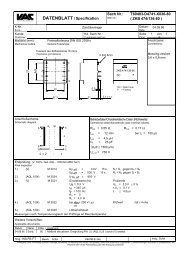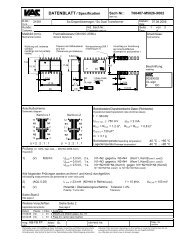PROPERTIES AND APPLICATIONS OF HIGH ... - Vacuumschmelze
PROPERTIES AND APPLICATIONS OF HIGH ... - Vacuumschmelze
PROPERTIES AND APPLICATIONS OF HIGH ... - Vacuumschmelze
You also want an ePaper? Increase the reach of your titles
YUMPU automatically turns print PDFs into web optimized ePapers that Google loves.
<strong>PROPERTIES</strong> <strong>AND</strong> <strong>APPLICATIONS</strong> <strong>OF</strong> <strong>HIGH</strong> PERFORMANCE MAGNETS<br />
W. RODEWALD <strong>AND</strong> M. KATTER<br />
<strong>Vacuumschmelze</strong> GmbH & Co. KG, P. O. B. 2253, 63412 Hanau, Germany<br />
Corresponding author e-mail: werner.rodewald@vacuumschmelze.com<br />
Abstract<br />
Neodymium-Iron-Boron (Nd-Fe-B) magnets are produced by powder metallurgy in large quantities<br />
and in many different shapes. Although the Curie temperatures of commercial Nd-Fe-TM-B alloys,<br />
TM: transition metals, range only between 310 and 360 °C, modern Nd-Fe-B magnets can be operated<br />
at temperatures up to 230 °C. The basic features, which determine the temperature stability of<br />
Rare Earth (RE) magnets are discussed in detail.<br />
Today many permanent magnet (pm) motors operate a large variety of machines, propel ships or adjust<br />
small sensors. In particular in motors and positioning devices the cogging torque of pm motors<br />
must be reduced. By novel and economic butterfly-shaped magnets, the cogging torque can be<br />
minimized.<br />
Sometimes RE-magnets need to be operated in hot and humid climates, what may result in corrosion.<br />
In particular the RE-rich constituents in sintered Nd-Fe-B magnets are prone to oxidation and<br />
Hydrogen embrittlement, what may result in a disintegration of surface layers. The basic principles<br />
of the corrosion mechanism in hot and humid climates are reviewed. By replacing the Nd-rich constituents<br />
by more stable compounds with a smaller electronegative potential, the corrosion stability<br />
of the sintered magnets could be improved significantly. New Nd-Fe-B magnet grades have a similar<br />
corrosion stability than common steels. In harsh operating climates, however, the Nd-Fe-B magnets<br />
need protection by proper coatings, which will be reviewed.<br />
In order to save weight or volume of magnet assemblies or in order to optimize efficiency, the maximum<br />
energy density of sintered Nd-Fe-B magnets has been increased by refined processing technologies.<br />
Nd-Fe-B magnets with a typical coercivity HcJ of 9.5 kA/cm achieve maximum energy<br />
densities up to 415 kJ/m³.<br />
Introduction<br />
Permanent magnets have become a key-component in many devices. Due to the high maximum energy<br />
density Rare Earth (RE) magnets are able to drive small motors in watches as well as strong<br />
motors in electric vehicles or huge electric machines for the propulsion of ships. Besides a large variety<br />
of motors high performance magnets are applied for fast and accurate positioning of the read- and<br />
writing heads in hard disc drives, to focus charged particle beams for medical or scientific investigations<br />
or to convert electrical signals into mechanical forces or vice versa.<br />
In many applications, RE magnets have to operate at elevated temperatures or in hot and humid climates.<br />
Hence the continuous maximum operating temperature as well as the temperature and corrosion<br />
stability determine the selection of the permanent magnet material. The basic features, essential<br />
for the temperature and corrosion stability of RE magnets, are reviewed.<br />
In the meantime heavy and large hydraulic devices are going to be replaced by permanent magnet<br />
motors, for instance in electronic power steering of vehicles or electronically assisted braking. In<br />
such motors the cogging torque must be minimized. Novel and economic butterfly-shaped Nd-Fe-B<br />
magnets meet such specifications, what will be demonstrated on permanent magnet motors.<br />
In order to save weight or volume of magnet assemblies or in order to optimize efficiency, the maximum<br />
energy density of sintered Nd-Fe-B magnets has been increased by refined processing technologies<br />
at the expense of reduced operating temperatures between 50 and 80 °C.<br />
1 Temperature dependence of permanent magnets<br />
The maximum continuous operating temperature of permanent magnets depends on the temperature<br />
coefficients TC(Br) of the remanent polarization, TC(HcJ) of the coercivity and the load line B/µ0H of<br />
the magnet or the magnet assembly. In general the maximum operating temperature of the different
permanent magnets increases proportional to the Curie temperature of the magnet materials, see<br />
Fig. 1.<br />
max. operating temperature in °C<br />
600<br />
500<br />
400<br />
300<br />
200<br />
100<br />
0<br />
Hard Ferrites<br />
(Nd,Dy) 2Fe 14B<br />
Sm 2(Co, Cu,Fe,Zr) 17<br />
SmCo 5<br />
AlNiCo<br />
0 200 400 600 800 1000<br />
Curie temperature in °C<br />
Figure 1: Maximum operating temperatures of permanent magnets in dependence on their Curie temperatures. The shaded<br />
lines give the lowest or the highest operating temperatures for different permanent magnet materials, respectively.<br />
Most of the RE magnets are produced by powder metallurgy in many different grades and shapes.<br />
The alloys are melted from RE metals, Fe and Fe-B master-alloys in vacuum-induction furnaces. The<br />
polycrystalline microstructure of the ingots implies, that the magnetic moments are distributed randomly.<br />
In order to achieve a well defined texture, powder metallurgy is applied. The alloys are crushed<br />
and milled to a fine alloy powder, that must consist of single crystals. In general alloy powders<br />
with an average particle size in the range 3 to 5 µm meet this requirement very well. Such alloy<br />
powders can be aligned by a magnetic field, compacted by cold isostatic pressing (CIP) to blocks, by<br />
axial (AP) or transverse (TP) field die-pressing to net-shape parts and sintered to compact anisotropic<br />
magnet materials [1 - 3].<br />
For many applications the maximum energy density is decisive. At room temperature Nd-Fe-B as<br />
well as Nd-Dy-Fe-TM-B magnets with strong coercivities HcJ >24 kA/cm, TM: transition metals,<br />
have got higher maximum energy densities than SmCo5 or Sm2(Co,Cu,Fe,Zr)17 magnets, see Fig. 2.<br />
But at temperatures of approximately 120 °C sintered Sm2(Co,Cu,Fe,Zr)17 magnets are superior.
max. energy density in kJ/m³<br />
450<br />
400<br />
350<br />
300<br />
250<br />
200<br />
150<br />
100<br />
50<br />
0<br />
0 50 100 150 200 250 300 350<br />
temperature in °C<br />
SmCo5 SmCo5 Sm2(Co,Cu,Fe.Zr)17<br />
Sm2(Co,Cu,Fe,Zr) 17<br />
Nd2Fe14B (Nd,Dy)2(Fe,Co)14B<br />
(Nd,Dy) 2(Fe,Co) 14B<br />
Figure 2: Maximum energy density (BH)m of RE magnets in dependence on the temperature.<br />
2 Temperature stability of sintered RE Magnets<br />
The temperature stability of permanent magnets is determined by reversible and irreversible polarization<br />
losses of the magnet material and of the load line B/µ0H of the magnet or of the magnet assembly,<br />
respectively.<br />
2.1 Reversible polarization changes<br />
The reversible polarization changes are represented by the temperature coefficient of the remanent<br />
polarization TC(Br), see Fig. 3. For temperatures between 20 and 100 °C typical temperature coefficients<br />
TC(Br) range from -0.08 to -0.11 %/K for sintered Nd-Dy-Fe-Co-TM-B magnets and amount<br />
to -0.04 or -0.03 %/K for sintered SmCo5 or Sm2(Co,Cu,Fe,Zr)17 magnets, respectively.<br />
2.2 Irreversible polarization losses due to the temperature dependence of the coercivity HcJ .<br />
Irreversible polarization losses are mainly caused by the temperature dependence of the coercivity<br />
HcJ and the thermal aftereffect. With increasing temperature the coercivity HcJ of RE magnets decreases<br />
and as a consequence the magnetization of grains, which have smaller coercivities, may be<br />
reversed. Such irreversible polarization losses do not depend on time, see Fig. 4. Hence irreversible<br />
polarization losses can be anticipated by an annealing treatment of the magnetized magnets. As a rule<br />
of thumb, such ageing treatments are performed at temperatures 10 to 20 K above the maximum operating<br />
temperature in order to stabilize the magnet or the magnet assembly, respectively.<br />
Typical temperature coefficients of the coercivity HcJ range from -0.50 to -0.75 %/K for sintered Nd-<br />
Dy-Fe-Co-TM-B magnets and amount to -0.14 to -0.25 %/K for sintered SmCo5 or -0.15 to<br />
-0.18 %/K for Sm2(Co,Cu,Fe,Zr)17 magnets for temperatures between 20 and 100 °C.<br />
Minor polarization losses are due to the thermal aftereffect or magnetic viscosity, respectively, and<br />
depend on time logarithmically [4]. Fig. 4 gives the relative irreversible polarization losses ∆Jirr/J in<br />
dependence on the exposition time at a temperature of 130 °C for sintered Nd14.3DyFe76.7B8 magnets
[5]. The irreversible polarization losses ∆Jirr due to the temperature dependence of the coercivity HcJ<br />
and due to the thermal aftereffect can be recovered by remagnetization.<br />
TC(B r ) =<br />
TC(H cJ ) =<br />
in %/K, T 0 < T < T 1<br />
20°C 60°C 80°C<br />
100°C<br />
-20 -15 -10 -5 0<br />
magnetic field strength H in kA/cm<br />
120°C<br />
Figure 3: Dependence of the demagnetization curves J(H) and B(H) of VACODYM ®*) 722 HR magnets on the<br />
temperature. The typical magnetic properties amount to: Br = 1.47 T, HcJ = 9.5 kA/cm, (BH)max = 415 kJ/m³ at 20 °C.<br />
rel. polarization losses dJ irr/J in %<br />
0<br />
-5<br />
-10<br />
-15<br />
-20<br />
-25<br />
Nd 14.3DyFe 76.7B 8 magnets<br />
Aging temperature: 130 °C<br />
1 10 100 1000 10000<br />
exposure time in h<br />
B/µoH = -2.0<br />
B/µoH = -1.1<br />
B/µoH = -0.5<br />
Fig. 4: Irreversible polarization losses of sintered Nd14.3DyFe76.7B8 magnets with different load lines B/µoH at a<br />
temperature of 130 °C in dependence of the exposition time.<br />
® registered trade mark of VACUUMSCHMELZE GmbH & Co. KG, *) licenser Sumitomo Special Metals Corp.<br />
1,6<br />
1,2<br />
0,8<br />
0,4<br />
0,0<br />
-0,4<br />
-0,8<br />
polarization J, induction B in T
2.3 Irreversible polarization losses due to microstructural changes<br />
However, irreversible polarization losses due to the deterioration of the magnet surface, for instance<br />
by oxidation, by improper cutting and grinding or by changes of the microstructure due to high temperatures,<br />
cannot be eliminated by remagnetization. Fig. 5 demonstrates the microstructure of an<br />
oxidized surface and the impact on the demagnetization curve J(H) [6]. Due to the oxidized surface<br />
layer the coercivity HcJ within this surface volume is strongly reduced. In particular the surface volume<br />
parallel to the easy axis of the magnet may be demagnetized by stray fields, what results in a<br />
step of the demagnetization curve J(H), see Fig. 5 on the left. The height of the step depends on the<br />
volume of the deteriorated surface layer parallel to the easy axis on relation to the volume of the<br />
magnet. In particular small magnets may experience essential changes in the demagnetization curve<br />
J(H).<br />
surface<br />
interface between<br />
oxidized layer an<br />
undamaged magnet<br />
perfect magnet<br />
selectively oxidized<br />
magnet<br />
polarization M<br />
magnetic field strength H i<br />
step from<br />
side surface<br />
Abb. 5: Influence of the oxidized surface grain layer on the demagnetization curve J(H) of sintered RE magnets. The<br />
enlarged microstructure of an oxidized layer of a Nd-Dy-Fe-TM-B magnet after annealing in air at 500 °C for 23 h<br />
demonstrates, that about one layer of grains is deteriorated [6].<br />
3 Commercial Nd-Dy-Fe-TM-B magnets for high operating temperatures<br />
The temperature stability of sintered Nd-Fe-TM-B magnets can be improved by stronger coercivities<br />
and higher Curie temperatures. Partial substitutions of Nd by Dy and of Fe by Co increase the coercivity<br />
and the Curie temperature, respectively. Besides small additions of Al, Cu, Ga, Sn, Ti, Nb, Mo<br />
a. s. o. promote the coercivity by refining the microstructure of the sintered magnets [1 - 3, 7].<br />
3.1 Magnetic Properties<br />
Optimized additions of Dy and Co results in RE magnets with a remanent polarization of 1.08 T for<br />
net shape magnets and a coercivity of 28.6 kA/cm at 20 °C. The maximum energy density amounts<br />
to 225 kJ/m³, see Fig. 6. With increasing temperatures a decrease of the coercivity cannot be prevented,<br />
but at 150 °C, the coercivity still amounts to about 12 kA/cm.<br />
The irreversible polarization losses in dependence on the temperature are compiled in Fig. 7 for<br />
magnets with different load lines B/µ0H. Due to the high coercivity a maximum operating temperature<br />
of 230 °C results for magnets with a load line B/µoH = -2.
20°C<br />
120°C 150°C 180°C 210°C<br />
-20 -15 -10 -5 0<br />
magnetic field strength H in kA/m<br />
240°C<br />
Figure 6: Demagnetization curves J(H) and B(H) of sintered net shape Nd-Dy-Fe-Co-TM-B magnets, grade<br />
VACODYM 688 AP, in dependence on the temperature. Typical magnetic properties at 20 °C amount to: Br = 1.08 T,<br />
HcJ = 28.6 kA/cm, (BH)max = 225 kJ/m³.<br />
irrev. polarization losses in %<br />
0<br />
-2<br />
-4<br />
-6<br />
-8<br />
-10<br />
temperature in °C<br />
1,6<br />
1,2<br />
0,8<br />
0,4<br />
0,0<br />
-0,4<br />
-0,8<br />
0 50 100 150 200 250 300<br />
B/µ 0 H = 0 - 0,5 -1<br />
-2<br />
Figure 7: Irreversible polarization losses of sintered net shape Nd-Dy-Fe-Co-TM-B magnets, grade VACODYM 688 AP,<br />
in dependence on the temperature for different load lines B/µ0H.<br />
polarization J, induction B in T
3.2 Special shapes for the reduction of the cogging torque in motors<br />
Most of the Nd-Dy-Fe-Co-TM-B magnets with strong coercivities are applied in motors. The rotors<br />
of such motors are assembled from thin platelets of high coercivity magnets, see Fig. 8 a), what can<br />
be performed automatically. After assembly the rotors are magnetized.<br />
Due to the interaction of the magnet poles with the stator slots, a cogging torque results. In order to<br />
minimize the cogging torque skewed arc shape magnet segment may be applied, see Fig 8 b) in the<br />
back. However the grinding of such skewed arc magnets consumes a lot of machining time due to<br />
individual holding tools and hence increases the manufacturing costs. In order to reduce the machining<br />
costs, novel butterfly-shaped magnets have been developed [8], see Fig 8 b) in the front.<br />
Butterfly magnets can be produced with similar skewing angles as skewed arc segments, but the<br />
grinding costs are more economic. Rotors may be assembled from single butterfly magnets or from<br />
axially stapled butterfly magnets, see Fig. 8 b) in the front.<br />
The cogging torques of 8-pole motors with different rotors are presented in Fig. 9. Rotors assembled<br />
from straight segments or platelets achieve a cogging torque of about ±5 N · cm, whereas rotors<br />
manufactured from skewed arc segments or from the novel butterfly magnets have got reduced cogging<br />
torques of
cogging torque in N cm<br />
6<br />
4<br />
2<br />
0<br />
-2<br />
-4<br />
-6<br />
butterfly magnet skewed arc straight segment<br />
180° 190° 200° 210° 220°<br />
angle<br />
230° 240° 250° 260° 270°<br />
Figure 9: Cogging torques of 8-pole brushless dc-motors with rotors assembled from straight segments, skewed arc segments<br />
or novel butterfly magnets, respectively.
4 Corrosion behaviour of sintered RE magnets<br />
In comparison to sintered Sm-Co magnets Nd-Fe-B magnets are more sensitive to corrosion. As a consequence<br />
all finished VACODYM magnets get a final surface treatment. Such magnets have been applied at<br />
ambient conditions (room temperature, humidity up to 50 %, no condensation of moisture) without any<br />
problems for more than 10 years in telephone transducers, for instance.<br />
In humid atmosphere, however, the Nd-rich constituents may be converted to Nd-hydroxides and some<br />
Hydrogen is released. The Hydrogen reacts immediately with the Nd-rich constituents and forms Ndhydrides.<br />
In such a humid environment Nd-hydrides are not stable and are transformed into Ndhydroxides.<br />
Since additional Hydrogen comes into existence the reaction cycle continues [9]. The formation<br />
of Nd-hydrides results in a strong volume increase of the Nd-rich constituents, so that cracks occur<br />
along the grain boundaries. The oxidation is accelerated at high temperatures. In the worst case the surface<br />
of the sintered Nd-Fe-B magnets disintegrates.<br />
As has been demonstrated by A. S. Kim [10] and B. Grieb [11] some time ago, the corrosion behaviour of<br />
Nd-Fe-B magnets can be improved by proper additions of Co, Nb, V, Mo, Cu, Ga etc. By these additions<br />
the Nd-rich constituents are transformed into more noble intermetallic compounds, see Fig. 10 inset, for<br />
instance Nd3(Co,Cu), (Nd,Dy)5(Co,Cu,Ga)3, Nd6(Fe,Co)13Ga [9 - 13]. Since the free electrochemical potential<br />
of these compounds were determined to be about 800 mV higher than that of pure Nd-metal, such<br />
Nd-Fe-B magnets are much more stable in hot and humid climates [9]. The corrosion behaviour is similar<br />
to pure iron or steels.<br />
4.1 Corrosion tests<br />
There are many different corrosion tests. A very common test is the Highly Accelerated Stress Test<br />
(HAST) which is similar to the standard IEC 68-2-66. The test samples are stored at 130 °C, 95 % humidity,<br />
2.6 bar water vapour pressure. Under these conditions no condensation of vapour occurs. The mass<br />
losses per surface area of the magnets are monitored in dependence of the exposition time. Standard Nd-<br />
Fe-B magnets suffer mass-losses of about 10 to 100 mg/cm² after 10 days, whereas the mass-losses of<br />
VACODYM 6xx magnets with an improved corrosion resistance amount to
mass losses in mg/cm²<br />
Matrix<br />
Oxides<br />
Nd-rich constituents<br />
Nd-Fe-B Nd-Dy-Fe-TM-B<br />
Nd 2 Fe 14 B Nd 2 (Fe,Co) 14 B<br />
Nd 2O 3<br />
Nd 2O 3<br />
Nd Nd-(Co,Cu,Al) x<br />
VACODYM 6XX<br />
standard Nd-Fe-B<br />
exposition time in days<br />
Figure 10: Mass losses per surface area of sintered Nd-Fe-B magnets or Nd-Dy-Fe-Co-TM-B magnets with an improved corrosion<br />
resistance in dependence on the exposition time. Highly Accelerated Stress Test (HAST): 130 °C, 95 % relative humidity,<br />
2.6 bar vapour pressure. The inset gives a model of the microstructure of standard sintered Nd-Fe-B magnets or new Nd-Dy-Fe-<br />
Co-TM-B magnets, respectively. The improved corrosion resistance is due to the replacement of the Nd-rich constituents by<br />
more noble Ndx(Co,TM)y compounds.<br />
Surface Thickness Method Colour Hardness Corrosion Temperature<br />
Resistance Range<br />
Sn >15 µm galvanic silver semibright HV 20 humid climate 10 µm galvanic silver semibright HV 350 humid climate 5 µm Ni +<br />
>10 µm Sn galvanic silver semibright HV 20 humid climate 5 µm spray- yellow 4 H excellent climatic, 5 µm IVD yellow 4 H excellent climatic, 15 µm EPP black 4 H excellent climatic, 6 µm EPP black 4 H excellent climatic,
5 Sintered Nd-Fe-B magnets with high energy densities and their applications<br />
The maximum energy density is determined by the remanent polarization and the reversible permeability<br />
µrev:<br />
( BH )<br />
J<br />
2<br />
max = r<br />
4 ⋅ µ o ⋅ µ rev<br />
(1)<br />
In order to achieve a high maximum energy density the remanent polarization has to be optimized. The<br />
remanent polarization Jr is determined by:<br />
J ( ) ( ) ρ<br />
r 20°<br />
C = J S 20°<br />
C ⋅ ⋅ ( 1−<br />
V ) f<br />
ρ<br />
nonmag ⋅ 0.<br />
01⋅<br />
ϕ<br />
(2)<br />
( ° C)<br />
0<br />
J s 20 , ρ ρ0<br />
, Vnonmag and fφ<br />
denote the saturation polarization of the Nd2Fe14B compound at 20 °C,<br />
the density related to the theoretical density of the alloy, the fraction of nonmagnetic constituents and the<br />
alignment coefficient, respectively.<br />
The alignment coefficient is defined by:<br />
⎛ ⎞<br />
f ϕ = (cosϕ ⋅100%)<br />
with ⎜ J r⊥<br />
ϕ = arctan 2 ⎟<br />
⎜ J ⎟<br />
⎝ r ⎠<br />
(3)<br />
and represents the average misalignment angle φ of the grains with respect to the easy axis [14].<br />
The precondition is a cylindrical symmetrical distribution of the misaligned grains. Magnets pressed isostatically<br />
or in an axial magnetic field meet this precondition fairly well. For magnets pressed in a transverse<br />
magnetic field the perpendicular components of the remanent polarization J r⊥<br />
parallel or transverse to the<br />
pressing direction are different. Hence for transverse pressed magnets two alignment coefficients have to<br />
be distinguished. The alignment coefficients can be easily determined from the remanent polarization measured<br />
parallel J and perpendicular J with respect to the easy axis of an anisotropic magnet [14].<br />
r<br />
r⊥<br />
5.1 Magnetic properties<br />
Optimized alloy-composition, proper alignment of the alloy-powders and controlled sintering and heat<br />
treatments result in isostatically pressed Nd-Fe-B blocks with a remanent polarization between 1.42 and<br />
1.47 T, coercivities of about 9.5 kA/cm and maximum energy densities between 380 and 415 kJ/m³, see<br />
Fig. 3. Such magnets achieve alignment coefficients >96 %, what indicates an average misalignment angle<br />
of
emanent polarization B r in T<br />
1,5<br />
1,4<br />
1,3<br />
1,2<br />
1,1<br />
1,0<br />
VACODYM 7xx TP<br />
VACODYM 7xx AP<br />
8 10 12 14 16 18 20 22 24 26 28 30<br />
coercivity H cJ(20°C) in kA/cm<br />
VACODYM 6xx AP<br />
VACODYM 6xx TP<br />
Figure 11: Remanent polarization of sintered net-shape Nd-Fe-B parts, produced by transverse field (TP) or axial field (AP) diepressing<br />
in dependence of the coercivity HcJ(20°C). VACODYM 7xx grades achieve high polarizations and maximum energy<br />
densities. The maximum operating temperatures amount to 50 up to 150°. VACODYM 6xx grades have got stronger coercivities<br />
HcJ and can be operated at temperatures between 110 and 230 °C.<br />
5.2 Applications<br />
Modern permanent magnets enable the design of small and fast disk drives for data storage in computers, a<br />
large number of accessories for automobiles in order to improve safety or comfort, tiny and sensitive sensors,<br />
transducers for acoustic applications, beam guidance assemblies for undulators in order to achieve<br />
brilliant light sources with ultrashort wavelengths, optical insulators for contolling data transmission, and a<br />
large variety of generators and motors. Some small motors with a diameter of 1.9 mm and a length of<br />
5.5 mm speed up to >100 000 rpm and achieve a power of 60 mW for moving microdevices. Besides all<br />
kinds of servo- and linear-motors, there are large machines with a diameter of 3.2 m and a length up to<br />
9.5 m. They are rotating slowly at 120 rpm, but achieve a power of 5 MW for the propulsion of ships. There<br />
are projects for machines with a power up to 18 MW.<br />
Lately more flexible MRI systems have come into application. The patients are no longer confined in a<br />
fixed solenoid or a C-shape magnet system. The magnet assembly resides underneath the patient table<br />
when not in use. At the push of a button a permanent magnet system is elevated to scanning position, so<br />
that intraoperative magnetic resonance imaging has become possible [17]. This procedure enables accurate<br />
imaging during surgery.<br />
Besides part body MRI systems have been developed in order to save time of whole body scanners for major<br />
clinical examinations [18]. Even for pets a variety of MRI systems have come into operation.<br />
Modern computer-controlled magnet assemblies are applied for the navigation of catheters or guidewires,<br />
which contain small permanent magnets at the tip, throughout the cardiovascular system of a patient [19].<br />
The tip of the interventional devices can be digitally controlled within 1 mm by the external fields and<br />
hence facilitates the manipulation of catheters by the physician.<br />
6. Summary<br />
By optimizing the alloy-composition and the processing route Nd-Fe-TM-B magnets with high maximum<br />
energy densities between 305 and 415 kJ/m³ can be produced. The remanent polarizations and coercivities<br />
vary between 1.26 to 1.47 T and 19 to 9.5 kA/cm, grades VACODYM 7xx. Due to the excellent remanent<br />
polarizations, these magnets have got smaller coercivities, what confines the maximum operating tempera-
tures between 50 and 150 °C. For applications which require superior temperature and corrosion stability<br />
Nd-Dy-Fe-Co-TM-B magnets with strong coercivities between 14.4 and 28.6 kA/cm are produced. The<br />
remanent polarizations and the maximum energy densities vary from 1.35 to 1.08 T and from 350 to<br />
225 kJ/m³, grades VACODYM 6xx, for instance. The maximum operating temperatures of these magnet<br />
materials range between 110 and 230 °C.<br />
By refining the processing technology even Nd-Fe-B magnets with a maximum energy density of<br />
453.6 kJ/m³, a remanent polarization of 1.519 T and a coercivity HcJ of 7.8 kOe can be prepared [16]. The<br />
laboratory tests set the pace for refining the production routes. In the last two decades there was a continuous<br />
improvement of the maximum energy density of sintered magnets from about 280 kJ/m³ in 1985 up to<br />
415 kJ/m³ in 2002.<br />
References<br />
[1] M. Sagawa, S. Hirosawa, H. Yamamoto, S. Fujimura, Y. Matsuura: Jap. J. Appl. Phys. 26<br />
(1987) 785 - 800.<br />
[2] K. H. J. Buschow: Handbook of Magnetic Materials, ed. K. H. J. Buschow, Amsterdam,<br />
Elsevier, Vol. 10, 1997, 563.<br />
[3] I. R. Harris: Magnet Processing Rare Earth Iron Permanent Magnets, ed. J. M. D. Coey,<br />
Oxford Univ. Press, 1996, 335 – 380.<br />
[4] L. Neél: J. Phys. Rad. 13 (1951) 339 – 351.<br />
[5] W. Rodewald: Proc 8 th Int. Workshop on RE Magnets and Their Applications, Dayton, 1985,<br />
737 – 745.<br />
[6] R. Blank and E. Adler: Proc 9 th Int. Workshop on RE Magnets and Their Applications, Bad<br />
Soden, 1987, 537 - 544.<br />
[7] J. Fidler, Th. Schrefl, S. Hoefinger, M. Hajduga: J. Phys. Condens. Matter 16 (2004) 455.<br />
[8] F. Jurisch: Patent Applications DE 10147310-A1, WO 2003034572-A1, US 2004028945-A1.<br />
[9] M. Katter, W. Rodewald, W. Fernengel, R. Blank, L. Zapf: IEEE Trans. Mag. 37 (2001) 2474.<br />
[10] A. S. Kim: Proc. 3 rd Int. Symp. Phys. Mag. Mat. (ISPMM’ 95), Seoul, 1995, 646 - 651,<br />
J. Appl. Phys. 79 (1996) 5035 – 5039.<br />
[11] B. Grieb: PCIM Europe 4 (1996), IEEE Trans Magnetics 33 (1997) 3904 – 3906.<br />
[12] K. Ohashi, Y. Tawara, T. Yokoyama, N. Kobayashi: Proc 9 th Int. Workshop on RE Magnets<br />
and Their Applications, Bad Soden, (1987) 355 - 361.<br />
[13] W. Fernengel, W. Rodewald, R. Blank, P. Schrey, M. Katter, B. Wall: J. Magn. Magn. Mat.<br />
196 – 197 (1999) 288 - 290.<br />
[14] W. Fernengel, A. Lehnert, M. Katter, W. Rodewald, B. Wall: J Magn. Magn. Mat. 157<br />
(1996) 19 – 20.<br />
[15] D. Süss, Th. Schrefl, J. Fidler, IEEE Trans Magnetics 36 (2000) 3282 – 323284.<br />
[16] W. Rodewald, B. Wall, M. Katter, K. Üstüner: IEEE Trans. Magnetics 38 (2002) 2955.<br />
[17] www.odinmed.com.<br />
[18] www.esaote.com.<br />
[19] www.stereotaxis.com.


